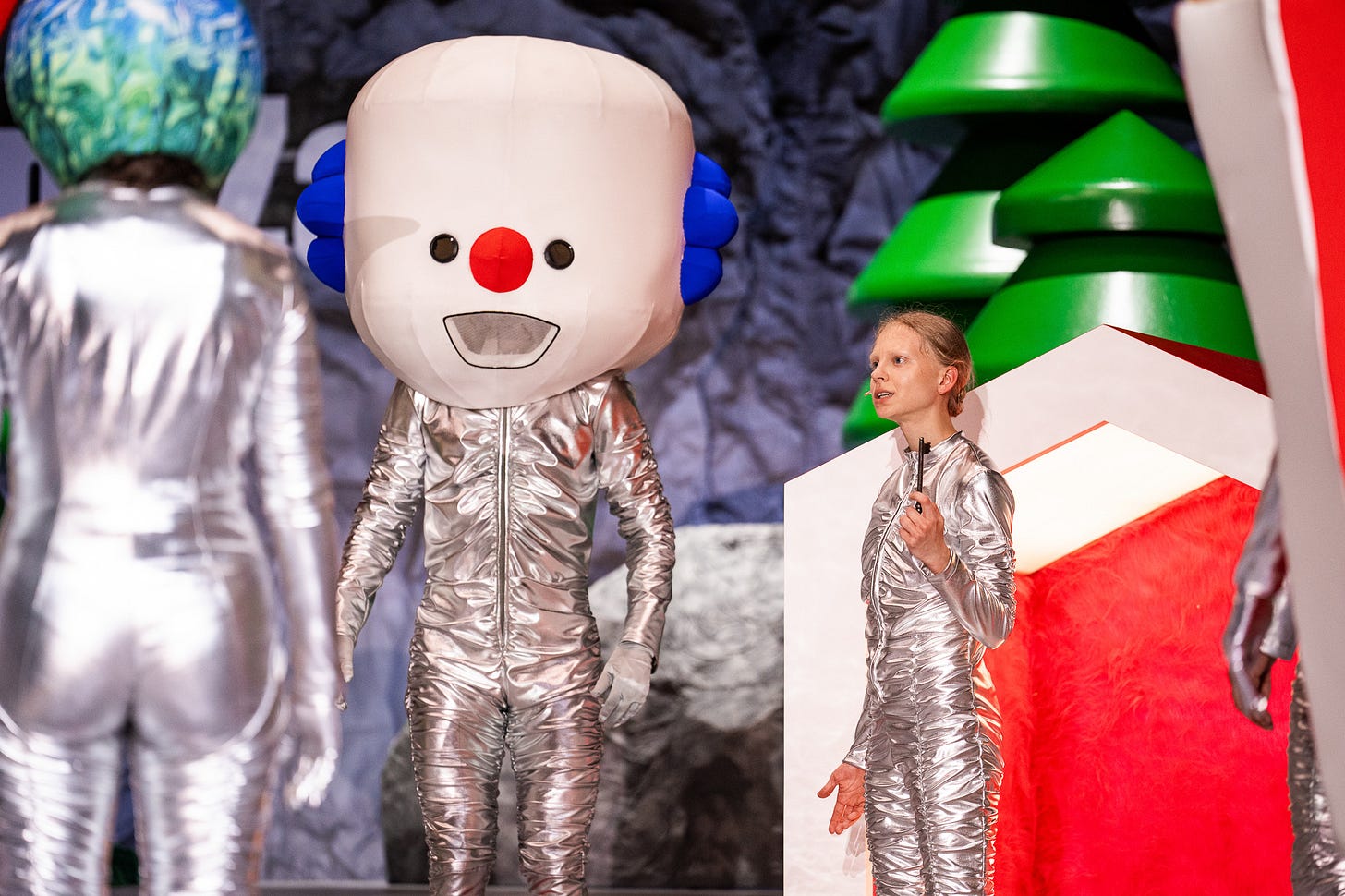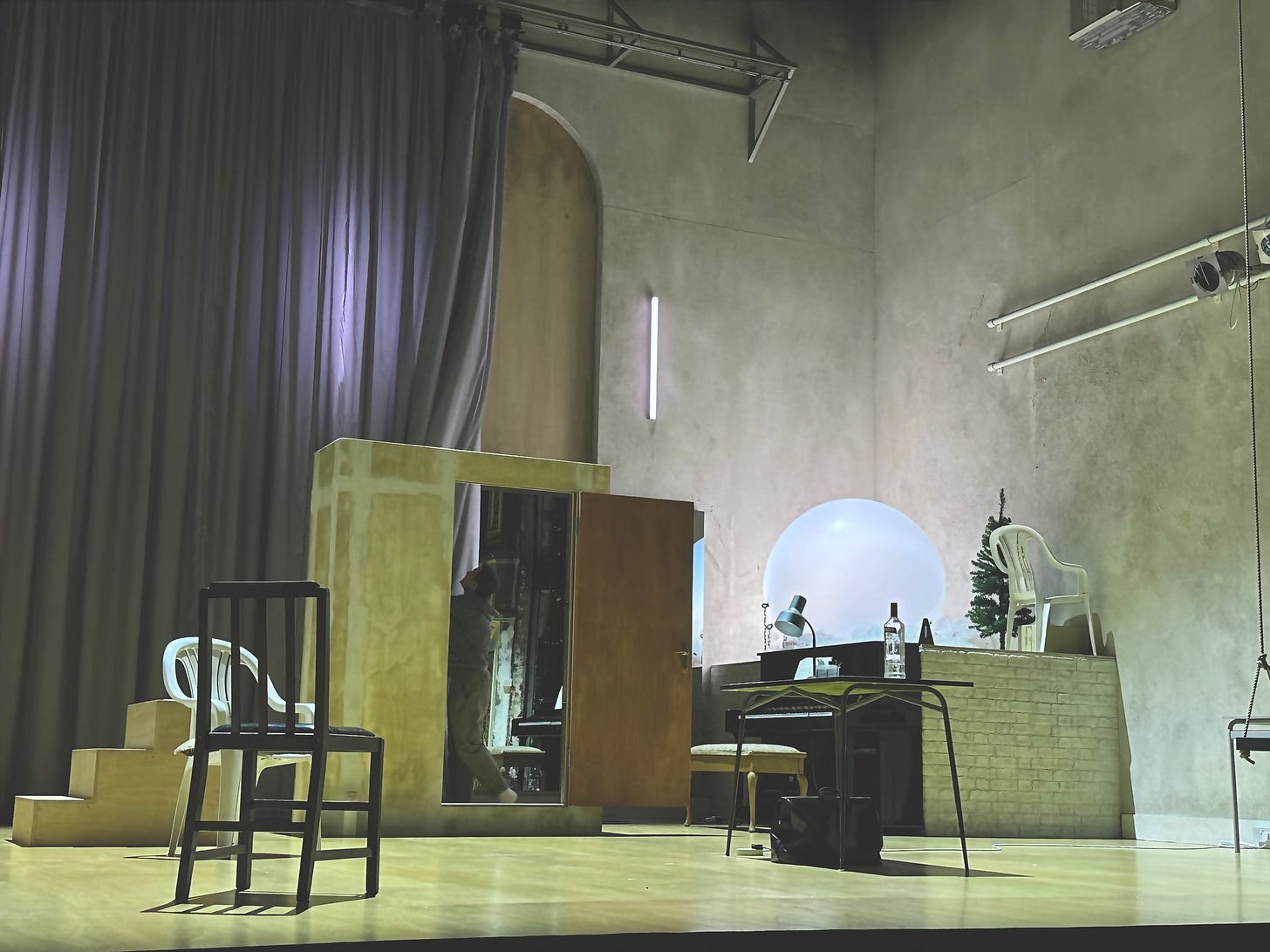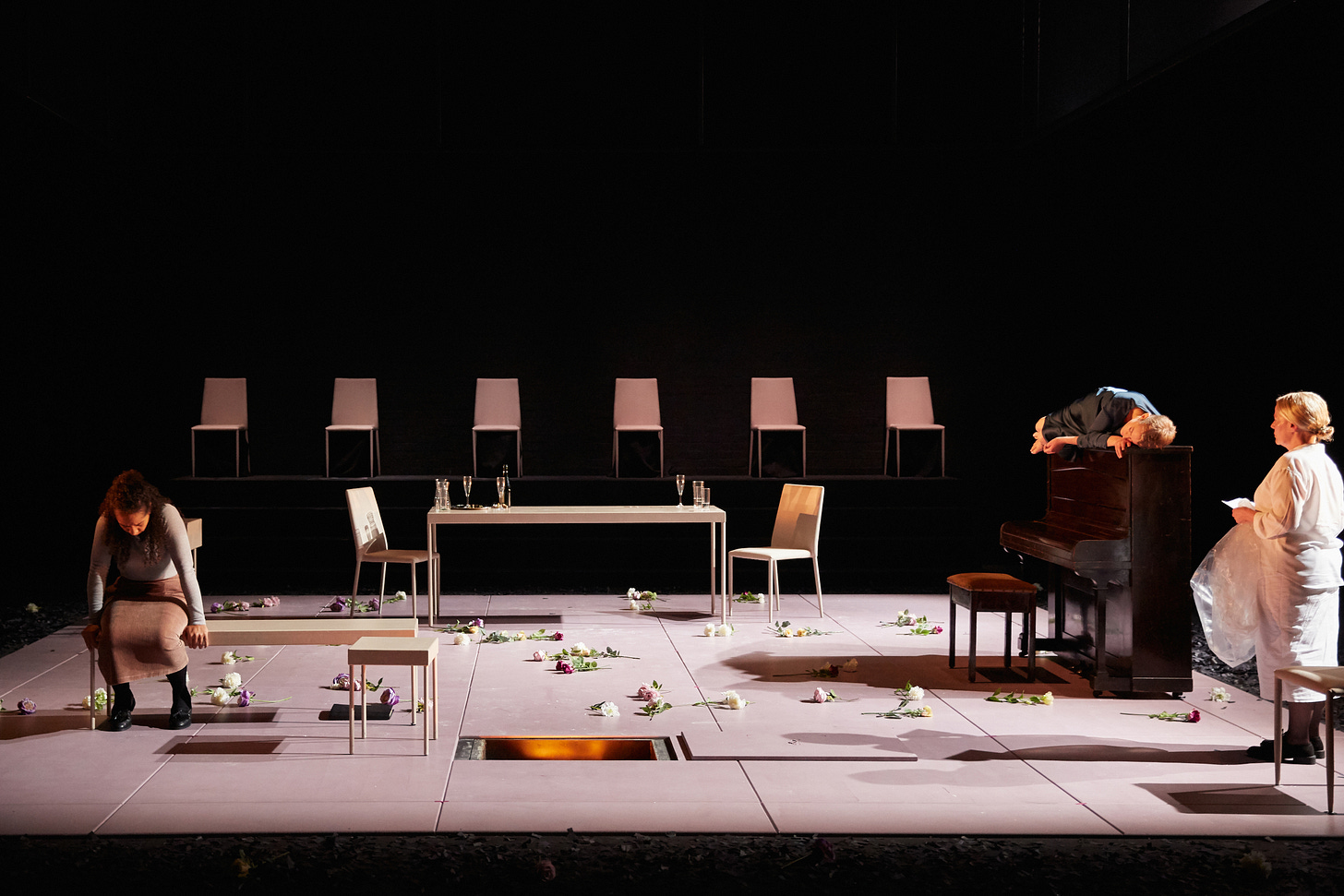By Rosemary Waugh
My mother is a champion knitter. Over the past year, I’ve acquired a number of huge Icelandic wool jumpers and cardigans – the kind of things you want to live in from January to March each year. And I’ve discovered that handknitted clothes are often as interesting to look at on the reverse as they are the ‘correct’ way around, because it’s by turning them inside out and studying all the layers of twisty stitches and scar-like seams that you truly get an appreciation of the skill that goes into creating them. It’s a little like looking at a complex architectural blueprint and starting to understand the hidden support structures that keep the building upright.
The set – and, to a lesser extent, costume – designs of Rosanna Vize often have a similar sense of being something that’s been turned inside out to reveal its seams. There’s a feeling of deliberate ‘undone-ness’ that could only arise from understanding what the same set and concept would look like if it were ‘done’ to a pernickety, shiny-surface level. You look and things are being exposed that aren’t normally exposed, and that makes you, in turn, a little bit uncomfortable – as if you too were sitting there semi-dressed and in need of some enveloping knitwear to cover you up.
One of the best examples of this is the Andrew Scott-starring Vanya, which had a teeny-tiny preliminary run at the Richmond Theatre before transferring to the Duke of York’s in September 2023. The production, which was co-created by playwright Simon Stephens, director Sam Yates and Vize, is famous for having Scott play every role in Chekhov’s melancholy, lights-fading play Uncle Vanya. That basic premise – the one everyone initially gasped over like an elderly Oscar Wilde character – came about during an early workshopping session for another version of Uncle Vanya that Stephens had written. That one featured all the regular characters, with the intention for them to be performed by the same number of actors as normal. Scott, an old collaborator of Stephens, was earmarked to play the doctor, but during the reading, he started – maybe seriously or maybe not – to read all the roles on the page and… the rest, give or take, is history. In a moment of spontaneous brilliance, they changed the play and production to Vanya: performed by just Andrew Scott. Isn’t that beautiful? Isn’t that just the kind of quick-on-your-feet, room-blowing-up stuff we need more of in theatre; more of in life?
And perhaps it’s that lack of stodgy reverence for how Chekhov had previously been done that fed into a design concept situated in the rehearsal room – that in-flux location of things in development. The box-here, box-there, bare-walled place that Scott paced around was populated by items found in real rehearsal spaces. This strange collection of objects included the totally mundane: a few of those hugely uncomfortable moulded plastic chairs, a bargain-basement kettle (the rudimentary stand-in for a samovar) and some student halls-worthy kitchen cabinets. They were mixed with a few stranger ones, most notably a lone swing that hung down on long, long ropes from the ceiling and a huge, illuminated ball that became the source of a contemporary, electric version of the relentless and heartbreaking light that permeates Chekhov's plays.
Even if those who watched Vanya were unaware this space was meant to represent a rehearsal room, they were surely aware it wasn’t meant to accurately recreate any setting found in the story. It better represented the mental state of Vanya’s title character – and, come to think of it, the doctor Scott was originally asked to play – in how the odd-bod, unmoored and unconnected collection of objects and geometrical shapes collectively pointed towards his own feelings of disconnection, desolation, and lost hope.
The idea of one man performing every role in a complex multi-character classic stretches the idea of ‘theatricality’ more than some people find comfortable. And, of course, it was Scott’s virtuosity that sold it in the end. But Vize’s set design similarly asks the audience to suspend disbelief in a more deliberate fashion than is often required. Yes, we know that all these characters are not really on stage. And, yes, we know that what we’re looking at is not the big old Russian house where they’ve congregated. Instead, it’s this place where everything is still a bit shonky, a bit up-for-grabs, and where everyone is consciously practising and trying on these different roles and characters, a bit like the way a teenager self-consciously tries out bits and pieces of identity. It doesn’t result in a production that is full-on meta, the way Dead Centre’s Chekhov’s First Play is genuinely meta but, like that turned-inside-out cardigan, it does feel as if the point is to reveal the underlying structure of Chekhov and, by extension, something about theatre and something about the human character in general.
Another Vize work with a comparable ‘let’s X-ray the canon’ dimension to it is the Hedda Gabler she worked on with director Chelsea Walker at Cardiff’s Sherman Theatre in 2019. The designer and director first started working on ideas for the show shortly after the infamous Ivo van Hove production starring Ruth Wilson at the National Theatre in winter 2016. Vize, as she told me in an interview, greatly admired that production but felt committed to discovering another way of doing Hedda that wasn’t in debt to or mimicking the Van Hove version.
Looking at the two shows side-by-side now, there are some sort-of similarities between Vize’s design and the one Jan Versweyveld created with Van Hove. Both utilise a very particular type of sleek, urban minimalism that felt so exciting, so contemporary and so ‘European’ five to ten years ago. And, in both, these wipe-clean domestic spaces became strewn and smeared with dirt, flowers, ashes and other ‘unclean’ natural substances during the course of the play.
But where Versweyveld’s was memorably white and enclosed, Vize’s was black and expansively open. A metal cage descended from the roof of the Sherman Theatre, partially separating off Hedda’s living quarters from the rest of theatre, but its translucent quality made it feel forever provisional, totally unlike the hermetically sealed box Wilson and her co-stars moved within at the National. Whether you liked the production or not (personally, I didn’t), Van Hove’s take on Ibsen was delivered with a very masculine definitiveness. This was his strong, solid take on the play, spelt out in thick black marker pen. It was different to other stagings, sure, but it wasn’t asking you to see the bones of Ibsen – it was asking you to admire the new suit Van Hove had dressed him in.
In contrast, Walker’s production with Vize’s crackled, sooty set design invited those watching to plunge beneath the surface and see the weirdnesses, the inadequacies and the hypocrisies of Ibsen’s work and the characters he created. The walls that separated off the main playing space from the other bits of the stage and the theatre were not intended as barriers to prevent the audience from seeing beyond them – pretty much the opposite. Like Vanya’s rehearsal space, the whole thing asked the audience to both believe and not believe in what they were seeing as a complete and solid world.
A more recent – and very different – example of this gentle mindfuckery can be seen in the explosively ridiculous set and costume designs Vize made for Jeff James’s rewrite of Shakespeare’s The Winter’s Tale. Performed at the Dailes Theatre in Riga, Latvia in 2024, the gleefully disruptive version relocated the story to the headquarters of a Silicon Valley tech company (a replacement for the normal Sicily scenes) and a threatening video game (the replacement location for the original Bohemia). Vize was inspired by the bubbly shaped and brightly coloured offices of Google and similar companies, whose all-in-one design – in-house gyms, restaurants and sleep pods – implicitly pressure employees never to leave. She also lent heavily on the visuals and emotional tenor of memes, and how they form part of an online culture which places the most violent and disturbing of content alongside the most fluffy, infantile, and inconsequential.
The figures who populate this online space – as performed by actors in silver jumpsuits wearing oversized plushie heads to make them look like animals, bananas, flowers or a carton of fries – are anything but cute. These are the emojis from Hell, more Dante’s Inferno than cutesy anime. It would be tempting to pseudo-celebrate the production’s design as something wild and fun and a bit unhinged. A good attempt at “making Shakespeare cool” by dunking him in contemporary colours. But like Vanya and Hedda Gabler – each using a totally different visual language – the overcaffeinated, always-online world of Winter’s Tale (James ditching the definitive article) isn’t lacking in reverence for the original text. Think of it instead as an exercise in digging pointed fingernails into one of Shakespeare’s strangest plays with the result that, once again, we’re plunged inside a design concept reflecting the psychological state of – in this case – King Leontes. Paranoia, loneliness and an ever-increasing disconnection from reality.
Or, put another way, a mind that’s been turned inside out.
Rosemary Waugh’s book Running the Room: Conversations with Women Theatre Directors is available now. She is currently working on Building the World: Conversations with Women Set Designers, due for publication by Nick Hern in 2026.












